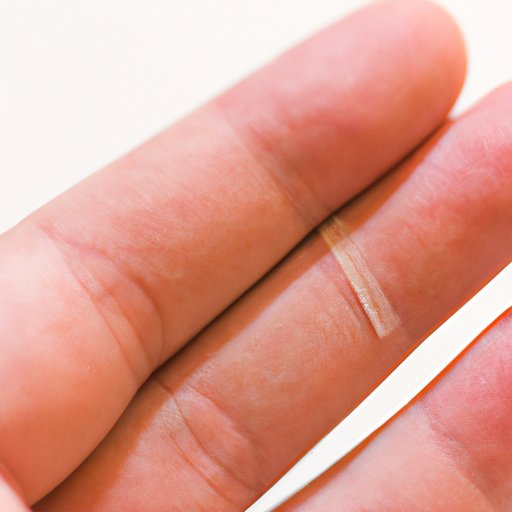
I. Introduction
A jammed finger is a common injury that occurs when your finger gets caught or bent suddenly, causing injury to the ligaments and joint. While it may seem like a minor injury, it can be incredibly painful and can interfere with your daily activities. It is important to seek prompt treatment to prevent further damage and expedite the healing process. In this article, we will explore simple remedies, step-by-step guides, do’s and don’ts, tips and tricks, and first aid measures to manage a jammed finger injury effectively.
II. 5 Simple Remedies to Heal a Jammed Finger Quickly
If you’re wondering how to fix your jammed finger, here are some simple remedies to consider:
Ice therapy
Apply ice to the affected finger immediately after injury to reduce swelling and pain. Wrap a bag of ice in a towel and hold it against the injury for fifteen minutes at a time, several times a day for maximum benefits.
Elevation
Elevating your affected finger above the heart level can help reduce swelling and pain. Prop your hand up with pillows or a sling to keep it elevated as much as possible.
Compression
Use a compression bandage or wrap the injured finger with adhesive tape to provide support, reduce swelling, and promote healing. Make sure the wrap is snug but not too tight and that it allows for proper circulation.
Immobilization
Immobilizing your finger with a splint or supportive wrap can help reduce pain, prevent further injury, and promote healing. Keep your finger immobilized for a few days, allowing the ligaments to heal properly.
Pain relief medication
You can take over-the-counter medication such as ibuprofen or acetaminophen to reduce pain and inflammation. Follow the dosage instructions carefully and do not exceed the recommended dose.
III. Step-by-Step Guide to Treating a Jammed Finger at Home
Here are some steps you can take to treat your jammed finger at home:
Assessment of the severity of injury
Assess the severity of your injury by checking for visible signs such as swelling, bruising, or discoloration. You can also test your finger’s range of motion and check for pain when moving it.
Immediate first aid measures
Follow the RICE method, as explained above, to reduce swelling and pain. If your finger is bleeding, clean the wound with soap and water, and apply antiseptic cream and a sterile bandage.
Self-care techniques
Rest your affected finger and avoid activities that cause pain or discomfort. You can also use essential oils such as lavender or peppermint to reduce pain and promote healing.
Follow-up care
Monitor your injury for several days and continue with the home remedies, as necessary. If your symptoms worsen or do not improve, seek medical attention.
IV. The Do’s and Don’ts of Managing a Jammed Finger Injury
Here are some do’s and don’ts to consider when managing a jammed finger injury:
Things to avoid to prevent further damage
- Avoid using the affected finger as much as possible to prevent further injury
- Avoid applying heat to the affected area, as it can increase swelling
- Avoid removing splints or wraps too early, as it can delay healing
Best practices to promote healing
- Rest and elevate your affected finger to reduce swelling and promote healing
- Use cold therapy and compression to reduce pain and inflammation
- Take medication as prescribed to manage pain and promote healing
Recommendations for safe and effective treatment
- Seek medical attention if your symptoms persist or worsen
- Use natural remedies, as necessary, to boost healing and promote relaxation
- Consider alternative therapies, such as acupuncture or massage, to promote healing and reduce stress
V. How to Speed Up Recovery from a Jammed Finger: Tips and Tricks
Here are some tips and tricks to speed up recovery from a jammed finger:
Nutritional support for healing
Eating a well-balanced diet rich in nutrients such as protein, vitamin C, and zinc can promote healing and help reduce inflammation. Avoid foods that can exacerbate inflammation, such as sugar, dairy products, and processed foods.
Exercises to improve range of motion
Performing gentle exercises to improve your finger’s range of motion can help reduce stiffness and promote healing. This may include simple finger stretches or squeezing a stress ball.
Alternative therapies, such as acupuncture or massage
Alternative therapies such as acupuncture, massage, or yoga can help reduce stress, improve blood circulation, and promote relaxation, all of which can boost healing and reduce pain.
VI. First Aid for a Jammed Finger: What You Need to Know
Here’s what you need to know about first aid for a jammed finger:
Signs of a serious injury
If you experience severe pain, deformity, or inability to move your finger, seek medical attention immediately, as these may be signs of a serious injury.
When to seek medical attention
If your symptoms do not improve after a few days of self-care, or if you experience severe pain, swelling, fever, or infection, seek medical attention immediately.
Treatment options for severe cases
If your injury is severe, your doctor may recommend a more aggressive treatment, such as surgery or physical therapy. Follow your doctor’s instructions carefully and stay proactive in your recovery.
VII. Conclusion
A jammed finger can be a painful and uncomfortable injury, but with prompt and proper treatment, you can expedite the healing process and get back to your daily activities. Remember to assess the severity of your injury, follow the RICE method, and avoid activities that cause pain or discomfort. Use a combination of home remedies, such as cold therapy and compression, and natural therapies, such as essential oils or acupuncture, to promote healing and reduce pain. Stay proactive in your recovery, seek medical attention if necessary, and be patient as your body heals.





